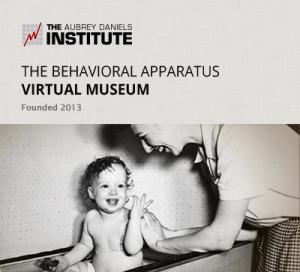Museum is a Highlight of New Aubrey Daniels Institute
 ATLANTA, Nov. 19, 2013 – Aubrey Daniels International (ADI), a leading workplace consultancy, today announced the opening of a one-of-a-kind virtual museum that brings to life the history of behavior analysis with a rich collection of photographs of apparatus, writings, diagrams and historical material that was created specifically for the museum and can be traced back 100 years.
ATLANTA, Nov. 19, 2013 – Aubrey Daniels International (ADI), a leading workplace consultancy, today announced the opening of a one-of-a-kind virtual museum that brings to life the history of behavior analysis with a rich collection of photographs of apparatus, writings, diagrams and historical material that was created specifically for the museum and can be traced back 100 years.
The Behavioral Apparatus Virtual Museum is a key feature of the Aubrey Daniels Institute, also unveiled today. The institute is dedicated to promoting the understanding and use of behavioral science, particularly to help organizations improve workplace performance and human relationships. (Please see this release for details on the institute.)
“Behavior analysis has been around for a century, but its potential for bettering the human condition remains underutilized,” said Aubrey Daniels, Ph.D., chairman and founder of ADI and the Aubrey Daniels Institute. “Our new museum provides tangible, fascinating information to enlighten and humanize behavior analysis. With the Institute more generally, we hope to encourage greater acceptance of the use of behavioral principles in the workplace and home, and to contribute to the development and dissemination of behavioral research."
The museum’s curator, noted behavior psychologist Andy Lattal, Ph.D., said: “We have assembled rarely seen apparatus that have contributed to the evolution of behavior analysis and its rise to a premier applied science with so many uses not only in the workplace, but also wherever we find human behavior, from schools to homes to institutions dedicated to improving the lives of children and adults.”
The following are some of the features of the museum that make it special:
- A comprehensive timeline of the history of behavior analysis.
- Historical material and commentary on behavior analysis pioneer B. F. Skinner’s innovative yet controversial “air crib.”
- A virtual room dedicated to the history of teaching machines, devices that Skinner thought would revolutionize education. From their inception in the 1940s and 1950s, these devices never quite caught on except among aficionados of behavior analysis. With the rise of the Digital Age, however, teaching machines and Skinner’s general technology of teaching have experienced a resurgence.
- Devices for making and delivering reinforcers in both the behavior laboratory and real-world settings, including one such device used in America’s early space exploration programs.
- Devices, large and small, for recording behavior, an important activity of any branch of science. Such devices provide the data from which principles of behavior are developed. These principles then find their way into human settings, where they can be used to benefit both individuals and the groups to which they belong.
Note to Reporters and Editors: Please find a prerecorded virtual tour of the museum here. Personalized tours also are available on request.
About Aubrey Daniels International
Founded in 1978 and headquartered in Atlanta, Aubrey Daniels International (ADI) works globally with a diverse spectrum of clients including many of the Fortune 500. It helps accelerate the business and safety performance of companies worldwide by using positive, practical approaches grounded in the science of behavior and engineered to ensure long-term sustainability. ADI supports its clients in accelerating strategy execution while fostering employee engagement and positive accountability at all levels of an organization.

